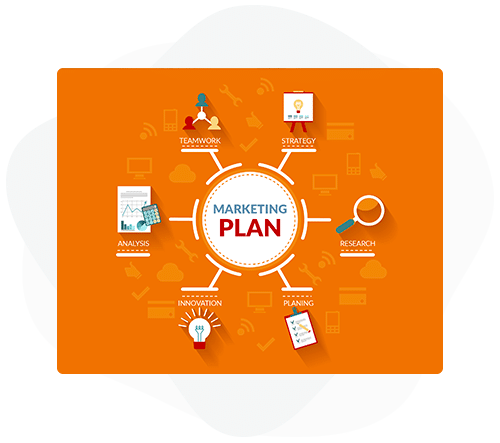How to Use Your CRM to Host a Successful Networking Event
Dec 20, 2023Networking events are an important way to begin and enhance working relationships with both potential clients and referral partners.

Would we expect less when it’s time to make a move? The National Association of Realtors says that 55% of 2018 home buyers started their purchase journey with either an online search for properties or for information on the home buying process.
A solid online mortgage marketing program will help lenders start a conversation with potential clients before they decide to act, whether for a purchase, refinance or other mortgage product. Furthermore, a plan will guide you in keeping the conversation going after those prospects have closed on a loan and may be ready to refinance. If you show up in their inboxes and social media feeds regularly, your name will be top of mind when they begin that online search.
The best place to start is by creating your own plan from scratch or adapting a digital marketing plan for mortgage companies – because as we all know, the mortgage industry has unique opportunities and its own set of challenges.
This Article Covers:
Whether you’re a mortgage marketing professional or a loan officer in need of marketing strategies to grow your personal pipeline, your digital marketing plan should align with your business’s goals.
Ultimately, many plans focus on generating increased closings efficiently, with minimal cost. Write down some numbers to help you measure your success. Consider a percentage increase in closings; number of leads or prospects added; or percentage of leads converted to prospects or prospects converted to in-process borrowers.

Look past the numbers, too. Consider how your digital marketing efforts will support your mortgage company’s mission statement. If you’re creating a plan as an individual mortgage professional, focus on showcasing your personal business values. You might include concepts like community support, customer service and consumer education.
It’s harder to set numeric goals for supporting a mission statement. Here are some to consider:

Most mortgage companies will market to the following groups, at least.
You might also think of your target audiences in terms of generations. First time buyers are more likely to be around 30, while homeowners don’t qualify for a reverse mortgage until they’re in their 60s. If your digital marketing plan includes social media platforms, you may want to consider posting more first time buyer materials on Instagram and more reverse mortgage information on Facebook, for example.
When you’re planning, prioritize communications with your target audiences based on your own way of doing business and the areas you would like to see the most growth.
Think about how you’ll get the word out. What channels will you use, and what’s your desired functionality for each? What target audiences will you reach? Here are some examples:
Email and/or Text Messaging
Get instant access to tried-and-true mortgage marketing strategies and guides with Mortgage Marketing University.
See how Surefire effortlessly develops content tailored to your brand. Sign up for a free look book today.
You have what it takes to be a top mortgage lender and Surefire has what it takes to get you there. Learn How!
Most mortgage companies will market to the following groups, at least.
You might also think of your target audiences in terms of generations. First time buyers are more likely to be around 30, while homeowners don’t qualify for a reverse mortgage until they’re in their 60s. If your digital marketing plan includes social media platforms, you may want to consider posting more first time buyer materials on Instagram and more reverse mortgage information on Facebook, for example.
When you’re planning, prioritize communications with your target audiences based on your own way of doing business and the areas you would like to see the most growth.
Think about how you’ll get the word out. What channels will you use, and what’s your desired functionality for each? What target audiences will you reach? Here are some examples:
Email and/or Text Messaging

Social (consider which platforms you’ll use for different types of messages)
Website and/or Blog
You’ll want to apply some unique industry considerations to your online mortgage marketing plan. These will need to apply to every marketing strategy, every piece of content, every target audience, and every action you take.
In your planning, account for both the features you’ll need to ensure are compliant and for any extra time to implement.
You may need to plan extra time both for setting up these systems and for the review of content as you create it later. Again, the best CRMs for the mortgage industry will help you in these areas.
The best way to find out what we offer is to try it out yourself. We’re confident that you’ll like what you see.
Many mortgage lenders rely on referrals from real estate agents for high quality leads. You’ll start seeing more leads coming in from your digital mortgage marketing efforts, too. Still your marketing plan should include ways to build relationships with referral partners. These might include:
A CRM created specifically for the mortgage industry like Top of Mind’s Surefire can help meet your cobranding needs plus address RESPA concerns around value sharing.
Remember the old Chinese proverb? “Tell me and I forget, teach me and I may remember, involve me and I learn.”
To help your potential borrowers learn and remember, you’ll want to include interactive online tools in your digital mortgage marketing plan. Calculators, video riddles and personalized animations will not only help your prospective clients absorb more information but will also go a long way toward engaging them and keep you top of mind.
In the mortgage industry, as in many others, speed-to-lead makes a noticeable difference. Seventy-eight percent of customers buy from the company that responds to their inquiry first. That’s almost 4 of 5 leads, simply by being the first to reach out!
To maximize your mortgage marketing, be consistent about adding contact forms to your messages. Just as importantly, employ a system for immediate automated responses and develop a plan for human follow up as needed.
All digital marketing plans should include ways to optimize all content for displaying on mobile devices. This is where consumers are most likely to receive your messages. Your email marketing, landing pages, mortgage website and your entire online presence should be designed for mobile display first.
This one may seem obvious, but it’s easy to overlook. It’s important to pay attention to your branding. You’ll want to ensure your company’s style, colors and proper logo are applied consistently.
Think about how, not if, you’ll incorporate video into your digital marketing plan. Ninety percent of consumers say a video helps them decide to buy. Consider these options:
Now that you’ve (finally!) worked through the preliminaries, it’s time to create an actionable digital marketing plan.

The primary part of your plan will address the types of communication you’ll use and details of each. Plans typically are arranged on a spreadsheet for easy organization. Here are primary components of a digital marketing plan for mortgage companies:
Your plan will also likely include linked documents and spreadsheets. You might attach:
Your digital marketing plan should be a living document that you can adjust to fit company needs, industry shifts, and mortgage compliance regulations as needed.
A mortgage loan officer marketing plan should be a fluid, ever-changing document, shifting with a market’s currents.
The best marketing strategies for mortgage brokers will include prioritizing timely content when markets are in flux. A strong mortgage broker marketing plan is one in which standard mortgage content is identified and scheduled and notes which sources to tap when timely content is needed.
When the market inevitably fluctuates, it’s important to take a deep breath, step back from the chaos that often accompanies a market change and re-evaluate your sales lead strategy. Start with questions about your business, then consider how each impacts messaging:
• Are there loan programs you should stop promoting in this new environment? If so, identify where you’re promoting those products in your mortgage marketing strategy and remove them.
• Are there loan programs you should start promoting in this new environment? If so, identify places in your marketing calendar to insert them, either as new messages or as replacements for others you remove.
• Will your prospects have new fears in this new environment? If so, identify or create content to reassure them (personal videos are great for this).
• Have educational needs about mortgage financing changed in the new environment? If so, adjust your educational messaging.
• Do you need to change your prospect mix? If so, update your marketing avenues accordingly.
The breadth of mortgage marketing strategies can also change with the markets. In normal times, where home prices and rates are stable, a year-long mortgage marketing plan may work well. When rates are variable and markets are changing quickly, a quarterly or even monthly plan may make more sense.
 In any environment, consider including space for interjecting timely content into automated mortgage marketing strategies. For example, in a mortgage social media plan, rather than scheduling four or five posts a week, schedule ahead for two or three posts. That way, there will be room to insert a quick live video or timely update when a newsworthy event happens.
In any environment, consider including space for interjecting timely content into automated mortgage marketing strategies. For example, in a mortgage social media plan, rather than scheduling four or five posts a week, schedule ahead for two or three posts. That way, there will be room to insert a quick live video or timely update when a newsworthy event happens.
An example is a shift from a low-rate mortgage market with a refinancing boom to a rising rate/rising price purchase environment. At that point, marketing strategies for mortgage loan officers should include removing most refinancing motivational messaging and refinancing calculators. In their place, a loan officer might add HELOC and HELOAN educational materials and calculators for current owners and ARM information for buyers. If refinancing information is kept, the messaging can be adapted to include instances where refinancing to a higher rate can be beneficial (such as a cash-out refi to help pay off higher-interest consumer debt).
Additionally, a mortgage marketing strategy in that new environment might include timely updates after Fed meetings or important financial news announcements. Personal videos or other educational messages could also be included to offer a brief history of rates and to reassure clients.
If the lender’s target audience will change along with the new products promoted, it also pays to re-evaluate distribution channels. A shift in a purchase market to first-time buyers, who are likely to be younger than existing homeowners seeking a refinance, might warrant a shift to a social media platform preferred by younger generations.
Finally, mortgage broker marketing strategies should consider referral partners in shifting markets. Lenders may need to expand referral partner marketing beyond real estate agents to include financial planners, divorce attorneys, insurance agents and other professionals.
The most important lesson to remember is that marketing strategies for mortgage brokers are not stagnant. Brokers must adjust their strategies with changes in market currents to keep their businesses sailing smoothly.
From independent mortgage banks to credit unions, community banks and brokerages, each home lending business is unique. The appropriate mortgage marketing plan for a home finance operation will vary based on team size, internal structure, geographical area, loan origination channels and performance goals.
For example, marketing best practices for consumer-direct lenders typically include wide-reaching outreach strategies that feature their branding front and center. Because consumer-direct loan originators rely on omnichannel marketing campaigns to generate new leads, it is beneficial to use an automated marketing system that takes on the burden of such broad outreach.
Alternatively, retail mortgage lenders tend to conduct more targeted outreach that supports forging personal, long-term relationships rather than casting a wide net. Retail mortgage loan officers will often nurture referral relationships over several years to earn new leads from their local real estate agent partners, and they rely heavily on past customer relationships for repeat business and referrals.
Wholesale lenders, on the other hand, work directly with other financial institutions, brokers and banks to process and underwrite loans. Mortgage marketing best practices that target third-party originators are business-oriented instead of consumer-facing because wholesale lenders need to manage an extensive partner database and reliably deliver accurate information about the loan products, rates and programs they offer.
All of these differences and more impact how lenders should formulate their mortgage marketing strategies. The bottom line is that if a lender wants predictable, measurable results from their outreach campaigns, first implementing a mortgage marketing plan structured to fit their organization’s needs may be needed.
Variety is the spice of life, which is why Surefire CRM and Mortgage Marketing Engine helps lenders embrace their unique communication style with out-of-the-box marketing workflows that support an array of outreach channels. With our intelligently automated, preconfigured Blueprints for Success Series, lenders can launch proven-effective, plug-and-play mortgage marketing plans without the hassle of manual workflow configuration.
The Blueprints for Success Series defines a clear path to solving problems and achieving business goals. These turnkey marketing tools cut implementation timeframes by weeks and allow mortgage loan officers and brokers to seamlessly deliver personalized, educational Surefire CRM creative content featuring their branding, headshot, contact details and even real estate partner information. With outreach rolling out completely hands-free, mortgage professionals can earn more repeat and referral business and ensure a quicker return on investment (ROI).
Whether a lender leverages our out-of-the-box marketing workflows or customizes them to fit their organization’s unique goals, the Blueprints for Success Series can help power predictable sales and recruitment marketing plans across the entire homeownership lifecycle:
Read the Blueprints for Success Series Guide to put your business on the fast track to ROI.
Creating a broad digital marketing plan is not for the faint-hearted. You may want to start by building a sample plan focused on a few platforms/channels or a single target audience.
Consider the resources available to help. Surefire CRM provides not only a place to manage your customer information but also a vast content library, the ability to schedule or trigger communications, set-it-and-forget-it workflows, and more.
Let us give you a look around. We are confident you’ll like what you see.
Get instant access to tried-and-true mortgage marketing strategies and guides with Mortgage Marketing University.
See how Surefire effortlessly develops content tailored to your brand. Sign up for a free look book today.
You have what it takes to be a top mortgage lender and Surefire has what it takes to get you there. Learn How!
Networking events are an important way to begin and enhance working relationships with both potential clients and referral partners.
Ad conversion rate measurement helps LOs gauge the effectiveness of their marketing spend. Surefire mortgage CRM can boost those metrics.
Credit union marketing strategies can benefit significantly if marketers utilize content designed from the start to foster engagement.